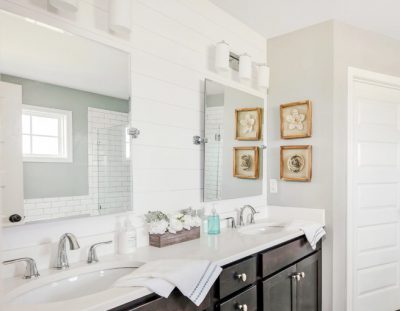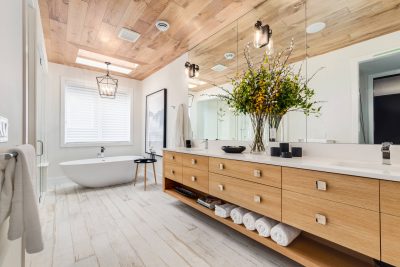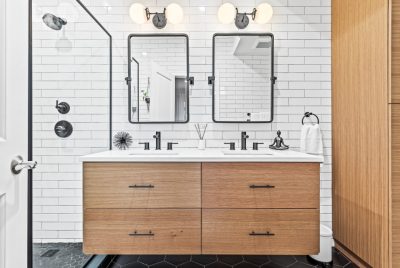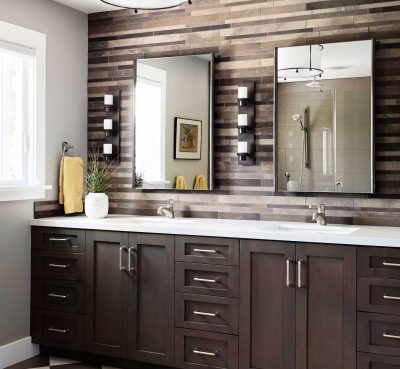If you’re renovating any room in your home, you want to know all your options.
There are plenty of them, and it can get to be overwhelming. One of your questions may be whether you can use vinyl flooring on your bathroom walls.
Let’s take a look at this possibility and see how it works!
Can You Use Vinyl Flooring on Bathroom Walls?
In short, you can use vinyl flooring on your bathroom walls. It is definitely a great option for covering your walls! There are several reasons that people choose to do this, which we’ll get into later.
You may also be interested in:
- 200+ Bathroom Ideas and Designs (Remodel & Decor Pictures)
- 40 Great Wall Decor Sticker Ideas for your Home
- The Simple Guide To Bathroom Tile Ideas
Why Might You Want to Use Vinyl Flooring on Bathroom Walls?
Many people choose to apply vinyl flooring to their walls as a design technique. This can bring a fresh take on your existing décor.
It’s pretty affordable and easy to use, which makes it a nice alternative to tile and other materials.
According to Do It Yourself, this can also make the walls easier to clean. That’s one reason that this technique is seen so frequently in kitchens and bathrooms.

How Much Does It Cost to Put Vinyl Flooring on Bathroom Walls?
This project will vary based on the type of vinyl you choose and how large your bathroom is. According to Home Wyse, vinyl flooring costs about $2.77 to $3.74 per square foot. This can be more expensive if you buy a higher quality vinyl.
Keep in mind that you might be able to get a better deal if you buy more vinyl. You could use the same vinyl in several bathrooms in your home or in a kitchen as well.
If you have existing tile or another type of wall that needs to be removed, that can add to the cost.
In addition to the vinyl, you will need to pay for the other materials.
What Materials Will You Need?
For one, you will need to buy vinyl. To make sure you get the right color and style, take pictures or bring samples from the store. This can help to prevent any major issues after the project is complete.
In addition to the vinyl, you will need a vinyl adhesive. Some vinyl flooring comes with adhesive stuck to the back already. Either option is fine and should work well.
You will also want to purchase a roller. It’s suggested that you buy a rubber roller, which will help to flatten the vinyl and make sure it’s intact. You will need a utility knife too, just in case you end up having to do any trimming.
What Steps Do You Need to Take to Complete This Project?
The entire process of covering your walls in vinyl flooring is very simple. It’s important to follow instructions so that you don’t have to redo the renovation.
You will want to start by cleaning your walls. This helps the adhesive to stick properly and keeps the surface nice and smooth.
Then, you can begin applying the vinyl flooring. Do It Yourself suggests starting at the middle of the wall.
Once the walls are completely covered, you can trim around the edges using a utility knife.
Finally, roll over the vinyl with a roller to make sure that everything is stuck with the adhesive. This will prevent the vinyl from rising up.
Can Other Flooring Be Used on Walls?
If you don’t want to use vinyl, you have some other options. According to Armstrong Flooring, you can also use hardwood, engineered tile, or wood-look laminate on your walls.
Vinyl is on the more affordable end, but all of these are alternatives to consider!
Can You Hire Someone to Put Vinyl Flooring on Your Walls?
You can absolutely hire someone to do this renovation. It is a fairly easy task, but not everyone wants to do this. Plus, it can be hard to find the time to make it happen. A contractor can be in and out of your home pretty quickly. You won’t even have to lift a finger!
Keep in mind that you will have to pay for the materials used and the hours that a contractor is working in your home. These costs can vary by contractor and by your area. In some cases, it can be much more cost-effective to do this on your own, but contractors are always an option!
Vinyl flooring is an inexpensive and easy way to update a bathroom or kitchen. Many homeowners have chosen this method and have been very happy with the results. Be sure to follow any advice that you are given in order to make sure this project goes smoothly!
If you’re renovating any room in your home, you want to know all your options. There are plenty of them, and it can get to be overwhelming. One of your questions may be whether you can use vinyl flooring on your bathroom walls. Let’s take a look at this possibility and see how it works!




























11 Responses
Love your idea of Vinyl on the walls! Beautiful!
I have to admit this is a new one for me! I had no clue you could use vinyl flooring on walls and this opens a whole new world for me. I won’t use it in my bathroom but I have a pantry that has to be redone and there’s no way in hell my budget allows me to go for the design I want but I think I could easily fake it with the right vinyl.
Can vinyl flooring (in a sheet) be used in a shower as a tub surround?
Probably, yes. Most sheet vinyl flooring is 100% waterproof.
Totally love this idea. I looking to do this in our new bathroom although the builder is not so sure about it. I am going to use a pattern behind a freestanding bath with the rest of the walls plain. I was considering making the floor the same pattern as the back wall but a bit worried it would be OTT. Any ideas?
It could work, but depends on the pattern.
Vinyl planks to be highly recommended for shower surround. What are your thoughts? How would you handle not having the “bull nose” edges though?
Hmmm, maybe use a metal edging as used on backsplash tile.
My vinyl flooring planks fell off the wall during the night. What did we do wrong? We used extra adhesive.
Can I use premium luxury vinyl tile as a built in bathtub surround? I have a very splash happy child that will never grow up. It would go up the wall about 28”.
Yes, LVT is waterproof and durable!